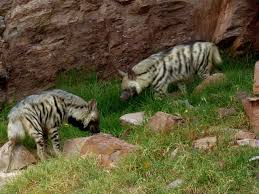The striped hyena is a species of hyaena native to North and East Africa, the Middle East, the Caucasus,
Central Asia and the Indian subcontinent. It is listed by the IUCN as near-threatened, as the global
population is estimated to be under 10,000 mature individuals which continues to experience deliberate and
incidental persecution along with a decrease in its prey base such that it may come close to meeting a
continuing decline of 10% over the next three generations.
It is the smallest of the true hyenas and retains many primitive viverrid characteristics lost in larger
species, having a smaller and less specialised skull. Though primarily a scavenger, large specimens have been
known to kill their own prey, and attacks on humans have occurred on rare instances. The striped hyena is a
monogamous animal, with both males and females assisting one another in raising their cubs. A nocturnal
animal, the striped hyena typically only emerges in complete darkness, and is quick to return to its lair
before sunrise. Although it has a habit of feigning death when attacked, it has been known to stand its
ground against larger predators in disputes over food.
The striped hyena features prominently in Middle Eastern and Asian folklore. In some areas, its body parts
are considered magical, and are used as charms or talismans. It is mentioned in the Hebrew Bible, where it
is referred to as tzebua or zevoa, though the species is absent in some Bible translations into English.
Description

The striped hyena has a fairly massive, but short torso set on long legs. The hind legs are significantly
shorter than the forelimbs, thus causing the back to slope downwards. The legs are relatively thin and weak,
with the forelegs being bent at the carpal region. The neck is thick, long and largely immobile, while the
head is heavy and massive with a shortened facial region. The eyes are small, while the sharply pointed ears
are very large, broad and set high on the head. Like all hyenas, the striped hyena has bulky pads on its
paws, as well as blunt but powerful claws. The tail is short and the terminal hairs do not descend below the
achilles tendon. The striped hyena lacks the enlarged clitoris and false scrotal sack noted in the female
genitalia of the spotted hyena. The female has 3 pairs of nipples. Adult weight can range from 22 to 55 kg
(49 to 121 lb), averaging at about 35 kg (77 lb). Body length can range from 85 to 130 cm (33 to 51 in), not
counting a tail of 25 to 40 cm (9.8 to 15.7 in), and shoulder height is between 60-80 cm (24-31 in). The male
has a large pouch of naked skin located at the anal opening. Large anal glands open into it from above the
anus. Several sebaceous glands are present between the openings of the anal glands and above them. The anus
can be everted up to a length of 5 cm, and is everted during social interaction and mating. When attacked,
the striped hyena everts its rectum and sprays a pungent smelling liquid from its anal glands. Its eyesight
is acute, though its senses of smell and hearing are weak.
Behavior
The striped hyena is a primarily nocturnal animal, which typically only leaves its den at the onset of total
darkness, returning before sunrise. Striped hyenas typically live in groups of 1-2 animals, though groups of
up to seven animals are known in Libya. They are generally not territorial animals, with home ranges of
different groups often overlapping each other. Home ranges in the Serengheti have been recorded to be 44 km2
(17 sq mi)-72 km2 (28 sq mi), while one in the Negev was calculated at 61 km2 (24 sq mi). When marking their
territory, striped hyenas use the paste of their anal pouch (hyena butter) to scent mark grass, stalks,
stones, tree trunks and other objects. In aggressive encounters, the black patch near the thoracic and
lumbar vertebrae is erected.

When fighting, striped hyenas will bite at the throat and legs, but avoid the
mane, which serves as a signalling device. When greeting each other, they lick the mid-back region, sniff
each other's noses, extrude their anal pouch or paw each other's throats. The species is not as vocal as the
spotted hyena, its vocalisations being limited to a chattering laugh and howling.
Reproduction
The striped hyena is monogamous, with the male helping the female to establish a den, raise young and feed
her when cubs are born. The mating season varies according to location; in Transcaucasia, hyenas breed in
January-February, while those in southeast Turkmenia breed in October-November. In captivity, breeding is
non-seasonal. Mating can occur at any time of the day, during which the male grips the skin of the female's
neck.
The gestation period lasts 90-91 days. Striped hyena cubs are born with adult markings, closed eyes and small
ears. This is in marked contrast to newborn spotted hyena cubs which are born almost fully developed, though
with black, unmarked coats. Their eyes open after 7-8 days, and the cubs leave their dens after one month.
Cubs are weaned at the age of 2 months, and are then fed by both parents. Despite the males' assistance,
female hyenas are very protective of their cubs, and will chase their mates away from the cubs if they
approach too closely. By autumn, the cubs are half the size of their parents. In the wild, striped hyenas can
live for 12 years, while in captivity they have been known to reach 23.
Diet
The striped hyena is primarily a scavenger which feeds mainly on ungulate carcasses in different stages of
decomposition, fresh bones, cartilages, ligaments and bone marrow. It crushes long bones into fine particles
and swallows them, though sometimes entire bones are eaten whole. The striped hyena is not a fussy eater,
though it has an aversion to vulture flesh. It will occasionally attack and kill any animal it can
overcome. It hunts prey by running it down, grabbing its flanks or groin and inflicting mortal wounds by
tearing out the viscera. In Turkmenistan, the species is recorded to feed on wild boar, kulan, porcupines
and tortoises. A seasonal abundance of oil willow fruits is an important food source in Uzbekistan and
Tajikistan, while in the Caucasus, it is grasshoppers. In Israel, the striped hyena feeds on garbage, carrion
and fruits. In eastern Jordan, its main sources of food are feral horse and water buffalo carcasses and
village refuse. It has been suggested that only the large hyenas of the Middle East, Asia minor, central
Asia and the Indian subcontinent attack large prey, with no evidence of their smaller Arabian and east
African cousins doing so. Because of its scavenging diet, the striped hyena requires more water to survive
than most other carnivores. When eating, the striped hyena gorges itself until satisfied, though hyenas with
cubs will transport food to their dens. Because of the high content of calcium in its diet, the faeces of the
striped hyena becomes white very rapidly, and can be visible from long distances.
Range and population
The striped hyena's historical range encompasses Africa north of and including the Sahel zone, eastern Africa
south into Tanzania, the Arabian Peninsula and the Middle East up to the Mediterranean shores, Turkey, Iraq,
the Caucasus (Azerbaijan, Armenia, Georgia), Iran, Turkmenistan, Uzbekistan, Tajikistan, Afghanistan
(excluding the higher areas of Hindukush) and the Indian Subcontinent. Today the species' distribution is
patchy in most ranges, thus indicating that it occurs in many isolated populations, particularly in most of
west Africa, most of the Sahara, parts of the Middle East, the Caucasus and central Asia. It does however
have a continuous distribution over large areas of Ethiopia, Kenya, and Tanzania. Its modern distribution in
Pakistan, Iran and Afghanistan is unknown with some sizable large number in India in open areas of Deccan
Peninsula. During the recent Afghanistan conflict, periodic sightings were reported in Kandahar Province
although not definitive.
Hunting
Striped hyenas were hunted by Ancient Egyptian peasants for duty and amusement along with other animals that
were a threat to crops and livestock. Algerian hunters historically considered the killing of striped hyenas
as beneath their dignity, due to the animal's reputation for cowardice. A similar attitude was held by
British sportsmen in British India. Although striped hyenas are capable of quickly killing a dog with a
single bite, they usually feign death when escape from hunting dogs is impossible, and will remain in this
state for long periods, even when badly bitten. On some rare occasions, hyenas were ridden down and speared
by men on horseback. Although hyenas were generally not fast enough to outrun horses, they had the habit of
doubling and turning frequently during chases, thus ensuring long pursuits. Generally though, hyenas were
hunted more as pests than sporting quarries; their scavenging damages skulls, skins and other articles from
hunter's camps, which made them unpopular among sportsmen. In the Soviet Union, hyena hunting was not
specially organised. Most hyenas were caught incidentally in traps meant for other animals. Some hunters in
southern Punjab, Kandahar and Quetta, catch striped hyenas to use them in hyena-baiting. The hyenas are
pitted against specially trained dogs, and are restrained with ropes in order to pull them away from the
dogs if necessary. In Kandahar, hunters locally called payloch (naked foot) hunt striped hyenas by entering
their dens naked with a noose in hand. When the hyena is cornered at the end of its lair, the hunter murmurs
the magic formula "turn into dust, turn into stone" which causes the animal to enter a hypnotic state of
total submission, by which point the hunter can slip a noose over its forelegs and, finally, drag it out of
the cave. A similar method was once practised by Mesopotamian Arab hunters, who would enter hyena dens and
"flatter" the animal, which they believed could understand Arabic. The hunter would murmur "You are very
nice and pretty and quite like a lion ; indeed, you are a lion". The hyena would then allow the hunter to
place a noose around its neck and pose no resistance on being dragged out of its lair.
The fur is coarse and sparse pelage, with the few skins sold by hunters often being marketed as poor quality
dog or wolf fur. Hyena skins were however once used in preparing chamois leather. The selling price of hyena
pelts in the Soviet Union ranged from 45 kopeks to 1 ruble, 80 kopeks.









